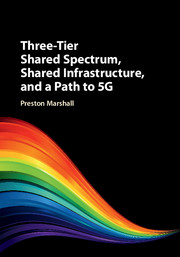Book contents
- Frontmatter
- Contents
- Acknowledgments
- Preface
- Part I Spectrum Sharing Background
- 1 Introduction to Three-Tier Spectrum Sharing
- 2 Prior Dynamic Spectrum-Sharing Regimes
- Part II Three-Tier Dynamic Spectrum Models
- Part III Components of a Three-Tier Architecture
- Part IV Protection Processes for Incumbents and Peers
- Part V Example Use of Three-Tier Spectrum: Use of the 3.5 GHz CBRS Band in the USA
- Part VI Future Bands, Network Services, Business Models, and Technology
- Part VII Appendices
- Index
- References
1 - Introduction to Three-Tier Spectrum Sharing
from Part I - Spectrum Sharing Background
Published online by Cambridge University Press: 30 August 2017
- Frontmatter
- Contents
- Acknowledgments
- Preface
- Part I Spectrum Sharing Background
- 1 Introduction to Three-Tier Spectrum Sharing
- 2 Prior Dynamic Spectrum-Sharing Regimes
- Part II Three-Tier Dynamic Spectrum Models
- Part III Components of a Three-Tier Architecture
- Part IV Protection Processes for Incumbents and Peers
- Part V Example Use of Three-Tier Spectrum: Use of the 3.5 GHz CBRS Band in the USA
- Part VI Future Bands, Network Services, Business Models, and Technology
- Part VII Appendices
- Index
- References
Summary
Overview
This book will develop the general principles of three-tier shared spectrum and shared infrastructure. Then it will explore what the impact of these principles will be on the deployment of future wireless generations, such as Fifth-Generation Wireless Systems (5G). These two highly related technology topics can fundamentally change the nature of wireless architectures as these architectures evolve from a focus on ensuring area coverage to high local capacity, and the transition from 4G to 5G technology and capability.
• Spectrum sharing, which creates the opportunity for access to common spectrum and technology by both traditional wireless operators and non-traditional operators, such as enterprises, and venue operators, and enables new sources of investment in high bandwidth services.
• Infrastructure sharing, which greatly expands the range of entities that can deploy wireless capacity, both reduces and shares costs, and creates bandwidth abundance.
• Extending the shared infrastructure model to 5G will require partnerships between operators and building and venue owners, operators and enterprises with access to siting, power, and backhaul.
Spectrum sharing is the enabler of infrastructure sharing. Spectrum sharing requires overcoming many technical, regulatory, and cultural obstacles, and much of this book will focus on overcoming these challenges. Infrastructure sharing requires these solutions for shared spectrum challenges, as well as significant changes in the concept and technology of a wireless operator, and the model of infrastructure deployment and control.
This emphasis represents the fusion of many concepts that have emerged in wireless practice, spectrum management, and an understanding of the conditions needed to encourage and promote innovation in technology and services. These considerations run the gamut from very technical considerations of path loss, link analysis and device performance, to national economic policy, economic and market principles, and fiscal policies. Creating these new opportunities that embrace and support modern wireless practice, together with policies that embrace and promote these new opportunities, is the challenge.
Individually, each of the underlying concepts is an evolutionary continuation of current thrusts. However, collectively, they offer a unique opportunity to utilize new technology approaches to solve fundamental challenges in the level of innovation in wireless ecosystems. This fusion is just in the process of being incepted in the United States of America (USA), but has already attracted massive industry interest, and it is inevitable that it will be viewed favorably worldwide.
- Type
- Chapter
- Information
- Publisher: Cambridge University PressPrint publication year: 2017



